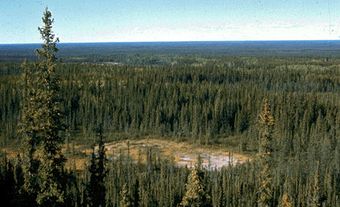An ecological reserve is a sub-category within the range of protected areas, and often one that is most protected from human activity. Protected areas, with names including national and provincial parks, conservation areas, wildlife preserves, ecologically significant areas and wilderness zones encompass a continuum of degrees of protection. Some protected areas permit hunting and fishing, timber extraction and motorized vehicles; others, such as ecological reserves, are managed to limit infrastructure and access associated with development or tourism. Managers typically use the International Union for Conservation of Nature (IUCN) Protected Area Classes to categorize the various protected areas. IUCN Class 1A (nature reserve/ecological reserve) is the most restrictive. If access is allowed, such as in British Columbia, visitation typically is limited to relatively passive activities such as nature appreciation, bird watching and hiking.
The purpose of ecological reserves is the protection of a valued natural feature, particularly when the fragility or rarity of the feature warrants minimal human activity. As such, scientists often promote ecological reserves as reference sites for monitoring of undisturbed ecosystems.
Ecological Reserves in Canada
Ecological reserves, like wildlife preserves or bird sanctuaries, are established to protect a natural feature by minimizing human activity. The difference is somewhat historical. In the early 1900s, game or bird sanctuaries were established mainly as no-hunting zones in order to increase game species which had been hunted or trapped to near extirpation. Ecological reserves became popular in the 1970s, a period when society placed increased value on non-game species, such as wildflowers, rare trees, insects and amphibians. Although game species may receive protection within the reserve, the selected sites were based mainly on non-game features. Reserves are a popular strategy to protect endangered species because full protection is often necessary when so few animals remain.
The foundation for many ecological reserves in Canada was the International Biological Program (1967-74) which identified the most important sites of biological value. Many of these sites eventually became reserves under a variety of names such as environmentally significant areas (most provinces), provincially significant wetlands (New Brunswick, Ontario, British Columbia), or important bird areas (BirdLife International and Nature Canada). For example, Marys Point Shorebird Reserve (1 km2) in New Brunswick, which supports 95% of the world's population of semipalmated sandpipers, is a national wildlife area, important bird area and Ramsar wetland.
Today, the term "ecological reserve" has become synonymous with the term "unique area" or "ecologically significant area" while conservation areas and national or provincial parks are synonymous with "representative ecosystems." There are also geographical differences; in southern Canada, ecological reserves often are smaller and mainly protect rare plants or animals. By contrast, most northern reserves, such as the Thelon Wildlife Sanctuary (52 000 km2), were established to protect large bird sanctuaries or game species; these sites are larger and more like traditional wildlife game reserves than ecological reserves.
Examples of Ecological/Nature Reserves across Canada:
British Columbia - Robson Bight (17.2 km2); killer whale sanctuary
Alberta - Athabasca Dunes (37.7 km2); migrating sand dunes
Saskatchewan - Crooked Lake Fen (0.2 km2); unique wetland
Manitoba - Armit Meadows (2.6 km2); remnant fescue prairie
Ontario - Quarry Bay (9.7 km2); rare plants
Quebec - André-Linteau (0.9 km2); rare forest
New Brunswick - Daly Point (0.4 km2); endangered butterfly
Prince Edward Island - Brudenell River (0.1 km2); riparian forest
Nova Scotia - Eighteen Mile Brook (0.6 km2); rare plant
Newfoundland and Labrador - Burnt Cape (3.6 km2); rare plants
Nunavut - Bylot Island Bird Sanctuary (0.6 km2); seabird nesting
Northwest Territories - Banks Island (142 km2); snow goose
Yukon - Horseshoe Slough (87.7 km2); waterfowl staging area
Administration
Compared to other categories of protected areas, the administration of ecological reserves is relatively simple. Many reserves deny or limit access, do not advertise the site for tourism activity, and have no, or very minor infrastructure requiring staff or maintenance. If access is restricted, reserves often are demarcated on the ground with signage and a cut line as a legal requirement to advise visitors that they are entering a site where many activities are restricted. Reserves with extensive ecotourism regulate activity in various ways, such as imposing restrictions on how close boat tours can approach nesting seabirds at Witless Bay, NL (31 km2).
Challenges and Initiatives
One challenge for ecological reserves is that they do not support typical land use models in society. A reserve does not fit today's multiple use paradigms of sustainable development and ecotourism wherein wise use of a resource is considered not only possible, but also desirable because its use can be justified to society for economic or social value. Society can support the curtailment of resource extraction or visitation for small pieces of land being set aside for reserves but political support for large ones is unlikely. As a result, most ecological reserves are very small, generally less than several square kilometres in more populated regions.
The small size of these protected areas is the main challenge. Small reserves are more vulnerable to natural disturbances or extrinsic forces such as forestry, mining, agriculture and urbanization that can isolate the reserve. The smaller the reserve, the more dependent it is on outside genetic and demographic inputs to remain viable. A common management response is the addition of buffer zones to minimize impacts of adjacent development.
The small size of reserves compounds our lack of knowledge on minimum area requirements for maintaining an ecological feature. Science is limited on such issues as how large a buffer needs to be around a grove of old-growth trees to reduce blowdown, or how water flow over a wide area influences the microhabitat of a cluster of rare orchids.
(See also endangered animals; endangered plants.)

 Share on Facebook
Share on Facebook Share on X
Share on X Share by Email
Share by Email Share on Google Classroom
Share on Google Classroom
